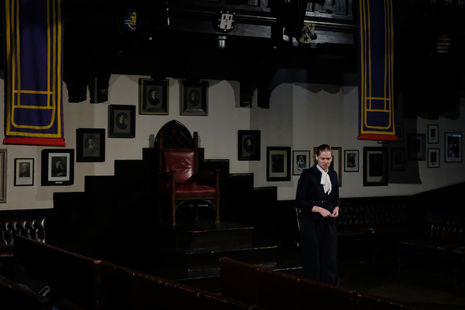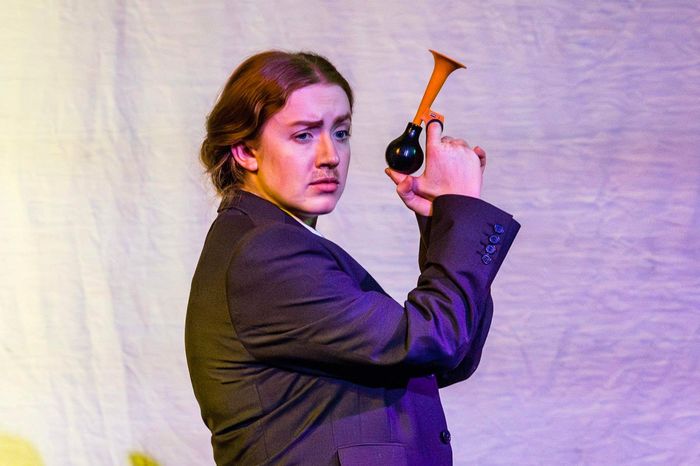King Lear ‘smells of success‘
Is King Lear the crowning glory of the Union’s Lent Termcard?

For a play centred around the politics of power, personal ambition, and intrigue, the Cambridge Union Debating Chamber - with its extensive history of controversial guests and debates - is perhaps the perfect venue for a performance of King Lear. With the production combining drama, physical theatre, choreography, and live music, this dark Shakespeare classic comes alive in innovative ways.
I am always intrigued when a show is performed in an unconventional space, and I felt that the creative ways in which the chamber was utilised really aided the production. Upon entering most characters traversed the long catwalk, the slow pace particularly drawing out and intensifying the audience’s view of the succession of corpses being dragged in at the end of the play. There was something sinister about the constant presence of actors looming over us on the balcony during the first half and the eerie echoing of their voices from above, which enhanced the supernatural undertones of the play. The use of lighting throughout was particularly impressive. When Edmund was plotting whilst wielding a knife, the blue wash created an appropriately icy atmosphere. These blue spotlights were well-utilised throughout the play, accompanied by torches and lanterns that cleverly illuminated the actors’ faces.
"This dark Shakespeare classic comes alive in innovative ways."
The motif of the chorus bearing lanterns added a dynamism to the play, and provided a gripping transition from the interval to the second half. They danced around the stage in a choreographed sequence to the increasingly high-pitched violin along with an underscore of thunder. Violinist Imaan Kashim must be commended for his skillful playing, which played a key role in building the ambience as soon as the bustling audience filed into their seats,
One unexpected aspect of the production was its open nature: the prop tables were visible as you entered, actors sat in the front row of the chamber in the opening scene, and the character of Edmund, played by Caelan Landers, was ominously lurking in the middle of the performance space before the show started. This almost interactive feature carried on throughout, particularly when the Fool, played by Christian Longstaff, hilariously shone a torch in the face of two audience members, or demanded applause after a distinctly comedic monologue, giving those moments an interesting pantomime-like feel.
Overall, the acting performances within the production were very strong, with both the lead and more minor characters contributing well. Gabriel Jones, who plays King Lear, powerfully commanded the stage with his booming voice. The commitment of Christian Longstaff to the character of the Fool was also praiseworthy, contorting and playing with his physicality to portray the chaotic character. Lib Hinze’s Oswald added some real nuance to the play, initially delivering a slightly camp depiction of the character, joking around whilst interacting with Aaron Tan the Banner Man, and then immediately switching to a more serious rendition when appropriate. Unfortunately, some performances did lend themselves to some slight overreacting, particularly in the cases of the ‘villainous’ roles, however this was not entirely inappropriate considering the melodramatic nature of a Shakespeare play.
"I felt that the creative ways in which the chamber was utilised really aided the production"
Highest praise should arguably go to blood co-ordinator Maisie Johnson, who was responsible for the most stupefying visual moments of the production. Gasps of horror echoed around the chamber as Regan, played by Lexie Graham, fatally wounded Gloucester’s servant; the dramatic reveal of gouged eyeballs and red streaked faces creating an unfortunately unforgettable scene. Yet, the pinnacle of horror was reached at the stabbing of Edmund. People’s hands flew to their mouths, staring in wide-eyed terror at the immense blood spatter which flew from Edmund’s stomach, leaving not a single inch of the stage untouched. The vividity and brutality of these visuals perfectly encapsulated a second act truly plagued by death.
The final tragic tableau proved to be the production’s crowning glory: the corpses of all three of Lear’s daughters slumped against his throne, while he reigned untouched above them. A haunting image highlighted by the audience’s sudden submersion into darkness.
When staging Shakespeare, costuming is always going to be a difficult task; with the big question remaining whether to commit to Shakespearian garb to tailor the production to a more modern aesthetic. This production chose the latter option, with each character leaning towards a “Sunday Best” use of formal clothing. Yet such a decision, in which the realm of dark grey clothing remained constant, became slightly confusing at points. With Kent wearing a beanie as a disguise and Regan forgoing the production’s grey palette for a bright orange dress which detracted from cast cohesiveness.
"The final tragic tableau proved to be the production’s crowning glory"
I came away from the production genuinely unsettled by the descent into madness depicted within the chamber, thoughts of devastating household power dynamics dominating my thoughts. Whilst I had never before seen a production of what has been described as, “the most perfect specimen of the dramatic art,” I would certainly say this production successfully delved into the heart of this distressing Shakespeare tragedy, combining phenomenal acting with unique stylistic choices.
 News / Proposed changes to Cambridge exam resits remain stricter than most7 May 2024
News / Proposed changes to Cambridge exam resits remain stricter than most7 May 2024 News / Cambridge students set up encampment calling for Israel divestment6 May 2024
News / Cambridge students set up encampment calling for Israel divestment6 May 2024 Features / Cambridge punters: historians, entertainers or artistes? 7 May 2024
Features / Cambridge punters: historians, entertainers or artistes? 7 May 2024 Sport / The ‘netball girl’: myth or reality?7 May 2024
Sport / The ‘netball girl’: myth or reality?7 May 2024 Theatre / A nuanced and neurodivergent Carrie comes to the ADC6 May 2024
Theatre / A nuanced and neurodivergent Carrie comes to the ADC6 May 2024






